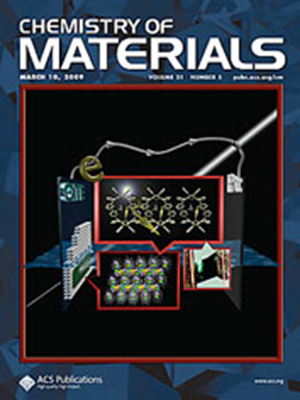聚合过程中工程非共价分子相互作用对可调聚两性聚合物性能的影响
IF 7.2
2区 材料科学
Q2 CHEMISTRY, PHYSICAL
引用次数: 0
摘要
传统的自由基聚合是一种普遍的合成技术,但由于统计性质和缺乏对非共价相互作用的控制,它在获得具有紧急性质的精确控制共聚物方面面临局限性。本研究通过开发一种方法来解决这些挑战,该方法可以通过在减压环境中使用气相单体来精确调整聚合过程中的非共价相互作用。利用引发CVD (iCVD),通过定制的非共价相互作用合成了在组成和溶解度方面难以控制的多两性共聚物。通过在量子化学计算指导下设计气相分子复合物,我们证明了具有广泛的非共价相互作用强度的多两性聚合物的合成。这些相互作用改变了多两性聚合物的亲水性和疏水性。至关重要的是,这些调节的相互作用显著影响了普通细菌的生物膜形成,为聚合物材料提供了一种途径,可以增强或减少生物膜的生长,范围从均聚聚合物上生长的5%到205%,用于工程活性材料或防污涂层。这项研究阐明了一种可扩展的、具有成本效益的方法来设计具有定制紧急特性的功能材料,为从过滤到生物材料等各个领域的应用创造了新的可能性。本文章由计算机程序翻译,如有差异,请以英文原文为准。

Engineering Noncovalent Molecular Interactions during Polymerization for Tunable Polyampholyte Properties
Conventional free radical polymerization is a prevalent synthesis technique, yet it faces limitations in achieving precisely-controlled copolymers with emergent properties due to the statistical nature and lack of control over noncovalent interactions. This study addresses these challenges by developing a methodology that enables the precise tuning of noncovalent interactions during polymerization through the use of vapor-phase comonomers within a reduced-pressure environment. Utilizing initiated CVD (iCVD), polyampholyte copolymers, which are conventionally difficult to control in terms of composition and solubility, were synthesized with tailored noncovalent interactions. By designing vapor-phase molecular complexes guided by quantum chemical calculations, we demonstrated the synthesis of polyampholytes with a broad range of noncovalent interaction strengths. These interactions altered the hydrophilicity and hydrophobicity of polyampholytes beyond those of the homopolymers. Critically, these tuned interactions significantly influenced biofilm formation by common bacteria, providing a pathway to polyampholyte materials with enhanced or reduced biofilm growth, ranging from 5% to 205% of those grown on homopolymers for applications in engineered living materials or antifouling coatings. This research elucidates a scalable, cost-effective approach to designing functional materials with tailored emergent properties, creating new possibilities for applications across varied sectors, from filtration to biomaterials.
求助全文
通过发布文献求助,成功后即可免费获取论文全文。
去求助
来源期刊

Chemistry of Materials
工程技术-材料科学:综合
CiteScore
14.10
自引率
5.80%
发文量
929
审稿时长
1.5 months
期刊介绍:
The journal Chemistry of Materials focuses on publishing original research at the intersection of materials science and chemistry. The studies published in the journal involve chemistry as a prominent component and explore topics such as the design, synthesis, characterization, processing, understanding, and application of functional or potentially functional materials. The journal covers various areas of interest, including inorganic and organic solid-state chemistry, nanomaterials, biomaterials, thin films and polymers, and composite/hybrid materials. The journal particularly seeks papers that highlight the creation or development of innovative materials with novel optical, electrical, magnetic, catalytic, or mechanical properties. It is essential that manuscripts on these topics have a primary focus on the chemistry of materials and represent a significant advancement compared to prior research. Before external reviews are sought, submitted manuscripts undergo a review process by a minimum of two editors to ensure their appropriateness for the journal and the presence of sufficient evidence of a significant advance that will be of broad interest to the materials chemistry community.
 求助内容:
求助内容: 应助结果提醒方式:
应助结果提醒方式:


